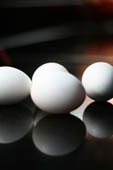
Purpose
To demonstrate the strength of an eggshell when weight and pressure is applied to it.
Additional information
The hardest natural substance on earth is a diamond. It's made from layers of compacted carbon and can only be scratched by another diamond. Diamonds form by carbon being exposed to high temperatures and pressures for millions of year’s deep underground. Eggshells are certainly no substitute for diamonds, but you may be surprised at just how strong they really are. In this experiment we'll explore the strength of eggshells by exerting pressure that gradually increases. How much weight will your eggshell handle before it cracks under pressure?
Sponsored Links
Required materials
- Two raw eggs of the same size
- Masking tape
- Fingernail scissors
- Several Large cans of food
- Several small cans of food
- Rigid cardboard
- Kitchen scales
- Cup
- Pen and journal to record results (optional)
Estimated Experiment Time
About 15 to 20 minutes
Step-By-Step Procedure
- 1. Wrap a strip of masking tape around the middle of each egg. Keep a gap between the ends of the masking tape. In other words, do not wrap the tape so it touches end-to-end.
- 2. Carefully make a small hole in each egg shell between the gaps in the tape. You can do this with the sharp tip of your fingernail scissors.
- 3. Empty the contents of each egg into a cup. Do this by pouring the contents of the egg through the holes you created.
- 4. Place the end of your fingernail scissors in the center of the holes you created. Cut around the middle of the eggshell covered with the masking tape. Separate the halves and trim off all jagged pieces until it's smooth and flat. You'll have 2 halves per egg (4 halves in total) of equal size. (NOTE: It's recommended to wash your egg shells at this point).
- 5. Place the half-eggshells on a hard flat surface (such as a table or tile floor), dome-side up. Place them in an arrangement so that they are close together and make a square.
- 6. Cut a square from your rigid cardboard that's about 1 inch larger on all sides than your egg formation.
- 7. Lay the square cardboard on top of the egg formation.
- 8. Place your largest can gently on the cardboard.
- 9. Stack on several additional cans one at a time. How many cans are you able to stack before one or more of the eggs starts to crack?
- 10. When one of the eggs crack, STOP! Take the cans off the egg platform and weigh them on your kitchen scale. Add the total to see how much weight your egg platform was able to withstand before cracking.
- 11. Write your results in a journal.
Note
It's recommended you wear latex gloves as touching raw eggs can pose a health risk. It's also recommended that you wash the inside of your eggs shells once you've cut them open. This will allow you to remove any access eggs whites and yolk from the interior walls of the shell.
Observation
How much weight did your egg platform withstand? Do you think it would have made a difference if you used more eggs for your platform? For example, 8 eggs instead of 4. What color eggs did you use? What if you were to use eggs of a different color (for example, white as opposed to brown). Would the result be the same?
Result
The strength of the egg is within its dome shape. No single point of the dome supports the whole weight of the cans on top of it. The weight spreads along the curved walls to the wide base, allowing the eggshells to support more weight. The principles in this demonstration are valuable to architects who strive to design safe buildings and structures that must support thousands of tons of weight.
Sponsored Links
Take a moment to visit our table of Periodic Elements page where you can get an in-depth view of all the elements,
complete with the industry first side-by-side element comparisons!